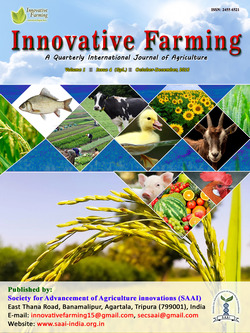
Effect of Graded Levels of Water Soluble Fertilizers on Growth, Yield of Mulberry and Cocoon Quality
Naveen, D.V.*
Department of Soil Science and Agricultural Chemistry, Chintamani-563 125, Karnataka, INDIA
Venkatachlapathi, V.
Department of Agronomy, Chintamani-563 125, Karnataka, INDIA
Vinoda, K.S.
Department of Sericulture, Chintamani-563 125, Karnataka, INDIA
Bharathi, V.P.
Department of Sericulture, Chintamani-563 125, Karnataka, INDIA
Ramakrishna Naika
Department of Sericulture, Chintamani-563 125, Karnataka, INDIA
Venkataravana, P.
College of Sericulture, Chintamani-563 125, Karnataka, INDIA
DOI: NIL
Keywords: Mulberry, Silkworm, Water soluble fertilizers.
Abstract
A field experiment was conducted at College of Sericulture, Chintamani, Karnataka, in randomized block design with seven treatments replicated thrice with drip irrigation. The treatments comprises of two sources of fertilizers viz., water soluble fertilizers (WSF) and conventional fertilizers (CF) at four levels (25, 50, 75 and 100% RD of WSF through fertigation) as per the schedule used for application of fertilizers. The type of soil is sandy clay loam in texture with neutral pH, EC of 0.24 dS m-1, 0.62% organic carbon, medium in available N, low in P and high in K content. Shoot height (m), Number of branches (No./plant) and Total number of leaves (No./plant) were higher in the treatment with 100 % RD with water soluble fertilizers against control and CF. Similar trends were observed for leaf yield/plant and leaf yield/ha. The uptake of N, P & K was higher in fertigation with 100% RDF through water soluble fertilizes + FYM (RD). But the performance of Silkworm, Bombyx mori L. in terms of cocoon weight (g/10 cocoons), Shell weight (g/10 cocoons) and Shell ratio (%) was higher in the treatment receiving 75% NPK through water soluble fertilizes (Fertigation) + FYM (RD). These findings indicated that inverse relationship between the nutrient accumulation in mulberry leaves and cocoon parameters in the silkworm B. mori that may be attributed to the increased accumulation of nutrients (particularly nitrogen) leads to decreased production of chlorogenic acid, Flavonal, and increased concentration of 1-deoxynojirimycine might have affected leaf quality and performance of silkworms.
Downloads
not found
Reference
Datta, R.K. 2001. Mulberry Cultivation and Utilization in India “Los arboles en la. produccio′n ganedera.” EEPF “Indio Hatuey”, Matanzas, Cuba, pp 25.
Ilakiyanila, K.S. 2012. Standardization of spacing and fertigation in cauliflower. M.Sc.Thesis, submitted to HC & RI, TNAU, Coimbatore.
Miyashita, Y. 1986. A report on mulberry cultivation and training methods suitable to bivoltine rearing in Karnataka, pp 1-7.
Mohanaramya, M., Rajamani, K., Sooriyanathasundaram, K and Rangasami, M.V. 2010. Effect of drip fertigation on yield, tuber characters and quality characters of glory lily. South Ind. Hort., 58: 97-101.
Muralikrishnasamy, K., S. V. Krishnasamy, V. Kumar and S. Sakthivel. 2006. Drip irrigation and fertigation in chillies. Seventh International Micro Irrigation Congress held at PWTC, Kualalumpur.
Sanchita, B., S. Luchon, B. Pankaj, Tridip and Bhaskarjyothi. 2010. Studies on effect of fertigation with different levels of N and K fertilizers on growth, yield and economics of early season capsicum under cover. Veg Sci., 37(2): 160-163.
Sugiyama, M., M. Takahashi, T. Katsube, A. Koyama and Itamura. 2016. Effects of Applied Nitrogen Amounts on the Functional Components of Mulberry (Morus alba L.) Leaves. J. Agric. Food Chem., 64: 6923-6929.
Rashmi, K., M.A. Shankar, K.R. Shashidhar and T.K. Narayanaswamy. 2009. Growth and foliar constituents of mulberry (M5) cultivated under organic based nutrient management. Int. J. Indust. Entomol., 19(1):165-169.
Rekha, K.B. and K. Mahavishnan. 2008. Drip fertigation in vegetable crops with emphasis on lady's finger (Abelmoschus esculentus (l.) Moench). Agri. Reviews, 29(3): 0253-1496.
Vijaya, D., N.A. Yeledhalli, M.V. Ravi, A. Nagangoud and V.P. Nagalikar. 2009. Effect of fertilizer levels and foliar nutrients on M-5 mulberry leaf nutrient content, quality and cocoon production. Karnataka J. Agric. Sci., 22(5): 1006-1012.
